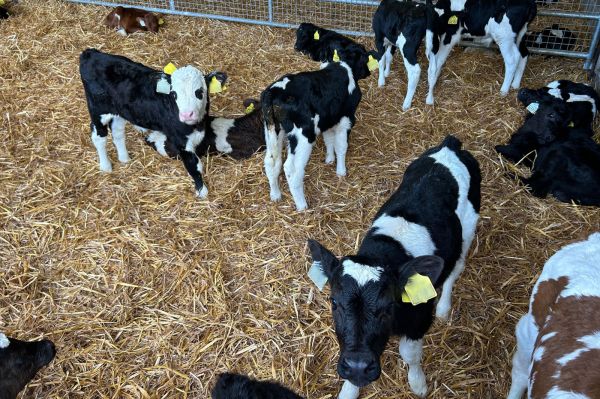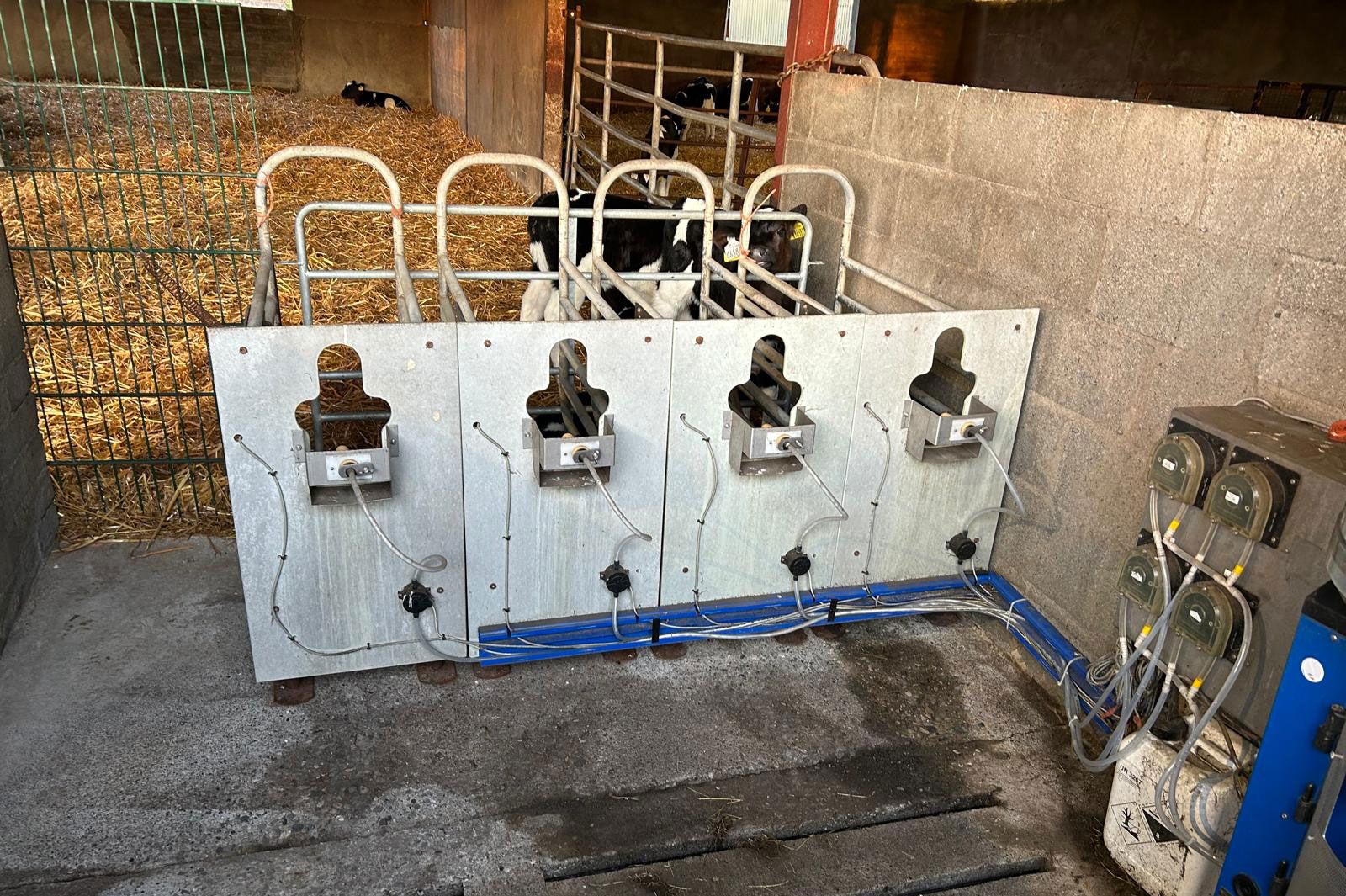Breaking new ground in dairy-calf health and welfare

In 2024, Irish calf exports dominated the live cattle trade, according to recently published statistics from Bord Bia. Overall, the sector was valued at €340m last year, an increase of almost 30 per cent on 2023 levels, and calf shipments accounted for 56 per cent of the total, or around 200,000 head. Live-calf exports from Ireland are hugely important, but they are in choppy waters.
EU proposals around transport time, mid-transport feeding, space allowance, and age of calf will, undoubtedly, have implications for our calf exports. Aspects of the Netherlands’ – our biggest importer of calves – ‘veal forward plan’ will also prove problematic. It sets out a maximum feeding interval of 14 hours, but total journey time there from Ireland is greater than that. Additionally, although not connected to calf transportation, that plan will signal a red light for Irish calf imports in 2026 because Ireland has not yet achieved an infectious bovine rhinotracheitis (IBR)-free status.
Physical feeding unfeasible
One aspect of the WELCalf project will address transportation issues for unweaned dairy calves. “The legislation is changing,” says Dr Kennedy. “Essentially, we are going to have to feed calves while they’re undergoing transport. So, the question arises, how do we do that? We must develop a way to feed calves while they are on the transport truck,” she adds. The researchers hope to develop a prototype automatic feeder that will allow calves to access milk replacer while being transported, and Teagasc is currently seeking a commercial partner to progress this. It is ambitious and will be costly but must be achieved.
Teagasc previously trialled mid-transport feeding from Ireland to the Netherlands last October using a truck brought in from Germany specifically for this purpose. It involved manual feeding by the transport staff, which is not a feasible long-term plan for a variety of reasons.
“So, what we need, essentially, is an automatic feeder in the trucks,” says Dr Kennedy. This is new territory but will be a game changer for live exports. She adds: “If we manage to develop it, I think there will be a lot of interest from Europe because there are a lot of young calves undergoing long-distance journeys on the continent, and the same rules will apply to them.”
Mitigating measures
Dr Conneely, who is heading up the live transportation side of the WELCalf project provides some further detail on research that has been done and what is to come: “What the [existing] research has shown us is that one of the main issues for calves when travelling from Ireland overseas involving truck and ferry transport, is the long feeding intervals – that is how long the calves spend without food. As a result, they get hypoglycaemic and that has welfare implications.” Dr Conneely has done extensive research into the welfare of dairy calves undergoing long-distance road and ferry transport as part of the MOOVE project.
She continues: “A lot of that work focused on looking at methods to mitigate these [implications]. So, in one study, we wanted to see if we fed calves more before the journey – an extra feed the night before and a bigger feed on the morning – do they [calves] do better than what was the standard protocol at the time. And they did. They were in better shape physiologically when they got as far as the lairage in France. But that effect didn’t actually last as far as the veal farm, because they’ve got another period [of transport] before they get there from the lairage, and they go again without food.”
Although the Moove researchers found that by feeding the calves more they could improve their physiological status, they were still outside of the reference range for glucose, as well as other indicators of energy balance, hydration and stress, explains Dr Conneely. “So, while they had better energy balance, they were still abnormal. Feeding them more improved them, but not enough,” she says.
This led to the mid-ferry feeding trial last October, as mentioned earlier. And while not a long-term solution, the effect of that experiment proved positive. Dr Conneely explains: “The calves were in better shape when they got to the lairage in France. And the calves that had received the feed midway through the ferry had higher glucose levels, but it was just logistically very challenging.”
Additionally, they found that the calves were inclined to lie down after feeding, Dr Conneely explains: “We had little pedometers on the calves to measure their behaviour, and we found that the ones that had received milk had a tendency to lie down a bit more. It was just a tendency. It wasn’t a clear effect, but they’re lying down a bit more potentially because they’re feeling a little bit more settled, and a little bit more comfortable following the feeds.”
The WELCalf project takes it from here, Dr Conneely explains: “The project aims to feed calves using an automated system so that each calf would get an allocated amount of milk replacer that they can access as they wish throughout the journey. It is basically using the same technology that is already in use for automatic feeding systems for calves on farms.” This automated feeding must also be individualised so that each calf is assured of its own feed allocation.
“Once we have a prototype, then we would intend to trial it and see does it work? Do calves drink from it when they’re allowed, when they have access, and we may do some sort of simulated studies first here.”

Individualised automatic calf-feeding technology is already in use on farms, so the researchers aim to replicate this in a live-exports truck environment. Photo: Matt O’Keeffe.
Precarious
Commenting on the precariousness of Ireland’s live calf exports, Dr Conneely says that they are a necessary component of Ireland’s farming system as it currently exists, so everything must be done to maximise the welfare of the animals: “From my point of view, these trips are happening, the calves are going abroad, and it is really important for everyone involved in the live transportation of calves to ensure that their welfare is of the highest standard. We want to make it as welfare-friendly a journey as possible. There are big challenges with that, but we are working to ensure that we minimise the stress they experience as much as possible.”
It is hoped that a prototype system may be ready to start testing next year – assuming all goes to plan. “The EU is looking closely at us, and they are happy that we are working to address this, but they want to see progress on it, so it is a high-priority task for us,” says Dr Conneely.
WELCalf goals
Live-exports transport, also known as ‘intra-community trade’, is just one aspect of the WELCalf project and there several other important calf-health issues that will be explored.
Teagasc has previously conducted dairy-farm research relating to both cow and calf health and welfare, but the missing research link has been in the area of dairy-calf-to beef farms, explains Dr Kennedy. “We aim to visit both dairy farms and dairy-calf-to-beef farms. We will look at the attitude of farmers towards calf rearing and calf welfare, and we will try to ascertain if there are barriers to ensuring high levels of welfare on both farm types.”
WELCalf researchers will also collect data on farmers’ current calf-rearing-management practices, and they will assess the housing infrastructure that’s available also. For example, Dr Kennedy explains, if a situation arises where calves have to stay on-farm for longer than expected, the research will ascertain if there is sufficient calf accommodation provided for them, what is the standard of those facilities, and are there any plans for future investment?
Dr Kennedy continues: “We’ll also look at the breeding policy that the farmers are putting in place: are they using sexed semen, or the Dairy Beef Index, how are farmers selecting bulls, and basically how are they adding value to non-replacement animals to make sure that they have a more saleable animal, an animal that dairy-calf-to-beef farmers would want to buy.
“Similarly, we’ll talk to the beef farmers and try to understand what they want, like, what would make it more likely for them to buy calves from a dairy farmer so that, potentially, we’d be able to find more homes for these calves.”
Baseline
WELCalf also aims to develop an application to collect real-time data relating to key animal-welfare traits. This information will help farmers identify the risk factors associated with poor health and welfare. Dr Kennedy explains: “We want to determine the baseline of calf welfare on Irish farms. Involved in this [project] are the ICBF, UCD and ourselves and the hope is that we will be able to develop an app where we’ll be able to collect data in real time in terms of health; if calves are being treated for illness or if there are instances of morbidity on the farm. We will collect that data and that in turn would feed into the ICBF database.”
Toolkit
Another facet of the research will look at the development of a calf-health ‘toolkit’, which will be led by lecturer and assistant professor at the UCD School of Veterinary Medicine, Catherine McAloon. With the toolkit, Dr Kennedy says, they want to ‘design and validate a suite of targeted calf-management interventions that promote best health outcomes in line with international best practice and calf rearing and bespoke to Irish dairy and dairy calf to beef systems’.
“We will visit the farms, do our baseline assessment, and if there are farms with issues, then we’ll go back to those farms and design a strategy specific to that farm to help improve the system and give the farmer [the tools of] the toolkit to address any issues and, hopefully, improve calf health and calf welfare. Then, we will reassess it and see how well this kind of specific tailored advice works in a given system.” The success of the toolkit will be assessed and that will determine its suitability for national rollout on farms. Additionally, the risk factors associated with summer scour syndrome will also be explored.
Keeping it simple
Dr Kennedy comments that, very often, when it comes to calf health and welfare, it is about getting the simple things right: “It is about getting the colostrum right, getting the hygiene right, knowing what to do if there’s an outbreak of scour. And while a lot of that information is already out there, people don’t necessarily always take that information on board. So as part of the research, we will work with the social scientists to try to understand why farmers may not be taking that information on board and to understand do we need to change our messaging to encourage people to do so?”
Results
According to the researchers, results will be shared from an early stage to maximise the impact of the research. And the knowledge outcomes will, they say, inform policy, change practice, drive more research, and be used for education purposes. The technologies developed during the course of the project can be used beyond the lifetime of this project to continue to provide ways of improving calf welfare. The various aspects of the research will run simultaneously with a dedicated team working in each area to make sure that the deliverables are achieved.




